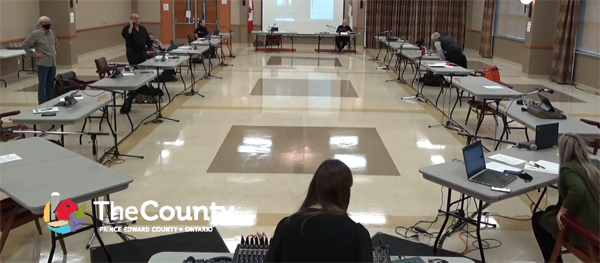Environmental committee plan may be too much, too soon for County to implement
Administrator | Oct 15, 2020 | Comments 0

Council’s Committee of the Whole meeting Thursday afternoon was fraught with audio technical difficulties. Tuesday’s regular meeting of council was recessed to a ‘Zoom’ online meeting Wednesday, also due to technical difficulty.
An ambitious plan by the County’s new Environmental Advisory Committee (EAC) appears to present too many challenges for the municipality to unfurl in the remaining term of council.
Council could be seen, but not heard, at Wednesday’s Committee of the Whole meeting, before technical audio problems allowed full function for about 40 minutes, before failing again.
Up to that point, councillor Kate MacNaughton was receiving support for a deferral to allow time for the CAO Office and Economic Advisory Committee to meet to clarify ideas and any mis-communication around the EAC’s strategic and working group plan time frames, and details.
“With the potential to have a significant impact on staff resources, the priorities of several departments and potential financial impacts, staff are recommending council clarify the priorities, or reduce the scope of items listed in the EAC proposed strategic plan,” Catherine Sinclair, the CAO’s Office executive co-ordinator states in a report to the Committee of the Whole.
“The financial impact is challenging to quantify at this point as it is heavily dependent upon council’s direction,” states Sinclair. “The staff recommendations outlined in this report are an attempt to move the municipality forward in the directions identified by the EAC, while also managing the fiscal impact and not adversely impact staff resources allocated to other priorities.”
Her report examines the six proposed strategic goals of the EAC and proposes modified priorities for council approval.
The report suggests the EAC review the draft Official Plan and provide comment before the draft comes before council in November. It recommends the EAC identify policies are of greatest priority so they can be a focus in early phases of policy and bylaw revisions to come before council in 2021.
It also recommends clarification of municipal focus, some deferrals, and redirection, to avoid duplication of efforts with current groups and committees.
The report also recommends a dedicated environmental page for EAC content on the County’s website, to support education and engagement. Finally, it notes a work plan would help staff understand direction, to implement operating budgets in relevant departments.
Councillors had heard some sobering math for taxpayers and stakeholders from its Environmental Advisory Committee. Jane Lesslie, chair, presented the deputation to council at Wednesday night’s meeting (moved from Tuesday due to ‘technical difficulties’ streaming) in her presentation of the committee’s strategic plan for 2020-2022.
“Since 2017 expenses incurred related to flood disaster/climate concerns account for $1.7 million in County spending,” stated Lesslie, adding Quinte Conservation reports $7,560,000 in crop insurance claims paid out due to the 2016 drought – in Prince Edward County.”
Water hauling costs due to drought in 2016 was a 100 per cent increase year over year costing $175,000 and she noted losses to households due to under insurance are unknown.
The County experienced extreme flooding in 2017 and 2019.
“The EAC believes action is necessary,” noting the next decade is critical in relation to projected global carbon dioxide emissions per year.
The County declared a ‘Climate Emergency’ in 2019. The first meeting of the Environmental Advisory Committee was held in February 2020. Its purpose is to co-ordinate information and provide strategic advice, and to engage with the public to identify and implement activities that support awareness. Members will also co-ordinate with experts and the public to mitigate effects of climate change, encourage water and energy conservation, foster waste reduction and encourage conservation or restoration of natural features and habitats.
Key areas of focus include integrating an environmental lens into the Official Plan, Secondary Plans, policies and bylaws. It wants to adopt best practices on watershed protection, flooding and drought management; and develop recommendations for tree canopy, landscape protection and regeneration, and foster wildlife diversity. The committee also hopes to identify and promote sustainable agriculture and reduce food insecurity and communicate with environmental leaders.
Proposed working groups cover topics of planning, natural cover, water security, environmental security of farming and food systems, engagement and communication and financing alternatives.
It seeks council approval of its six focus areas, staff assistance to recruit participants and approval of working groups. The committee notes it would provide interim reports to council, at minimum, on an annual basis.
Lesslie, and other community members of the committee, have extensive environmental-focused backgrounds.
Members include Eva Bednarczuk, Andy Bowers, Rachel Kuzmich and Angus Ross. A youth member position is vacant. Along with technical experts Mark Boone, from Quinte Conservation, and Jillian Van Patter, from Hastings Prince Edward Public Health, they work with councillors Stewart Bailey, John Hirsch, Kate MacNaughton and Mayor Steve Ferguson.
Click the link to see the EAC strategic plan, with staff recommendations: CAO Office on EAC plan
Filed Under: Featured Articles
About the Author:
































